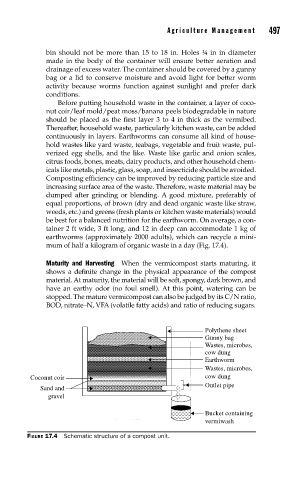Page 525 - Biosystems Engineering
P. 525
Agricultur e Management 497
bin should not be more than 15 to 18 in. Holes ¼ in in diameter
made in the body of the container will ensure better aeration and
drainage of excess water. The container should be covered by a gunny
bag or a lid to conserve moisture and avoid light for better worm
activity because worms function against sunlight and prefer dark
conditions.
Before putting household waste in the container, a layer of coco-
nut coir/leaf mold/peat moss/banana peels biodegradable in nature
should be placed as the first layer 3 to 4 in thick as the vermibed.
Thereafter, household waste, particularly kitchen waste, can be added
continuously in layers. Earthworms can consume all kind of house-
hold wastes like yard waste, teabags, vegetable and fruit waste, pul-
verized egg shells, and the like. Waste like garlic and onion scales,
citrus foods, bones, meats, dairy products, and other household chem-
icals like metals, plastic, glass, soap, and insecticide should be avoided.
Composting efficiency can be improved by reducing particle size and
increasing surface area of the waste. Therefore, waste material may be
dumped after grinding or blending. A good mixture, preferably of
equal proportions, of brown (dry and dead organic waste like straw,
weeds, etc.) and greens (fresh plants or kitchen waste materials) would
be best for a balanced nutrition for the earthworm. On average, a con-
tainer 2 ft wide, 3 ft long, and 12 in deep can accommodate 1 kg of
earthworms (approximately 2000 adults), which can recycle a mini-
mum of half a kilogram of organic waste in a day (Fig. 17.4).
Maturity and Harvesting When the vermicompost starts maturing, it
shows a definite change in the physical appearance of the compost
material. At maturity, the material will be soft, spongy, dark brown, and
have an earthy odor (no foul smell). At this point, watering can be
stopped. The mature vermicompost can also be judged by its C/N ratio,
BOD, nitrate–N, VFA (volatile fatty acids) and ratio of reducing sugars.
Polythene sheet
Gunny bag
Wastes, microbes,
cow dung
Earthworm
Wastes, microbes,
Coconut coir cow dung
Outlet pipe
Sand and
gravel
Bucket containing
vermiwash
FIGURE 17.4 Schematic structure of a compost unit.

